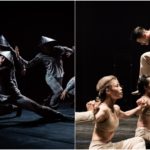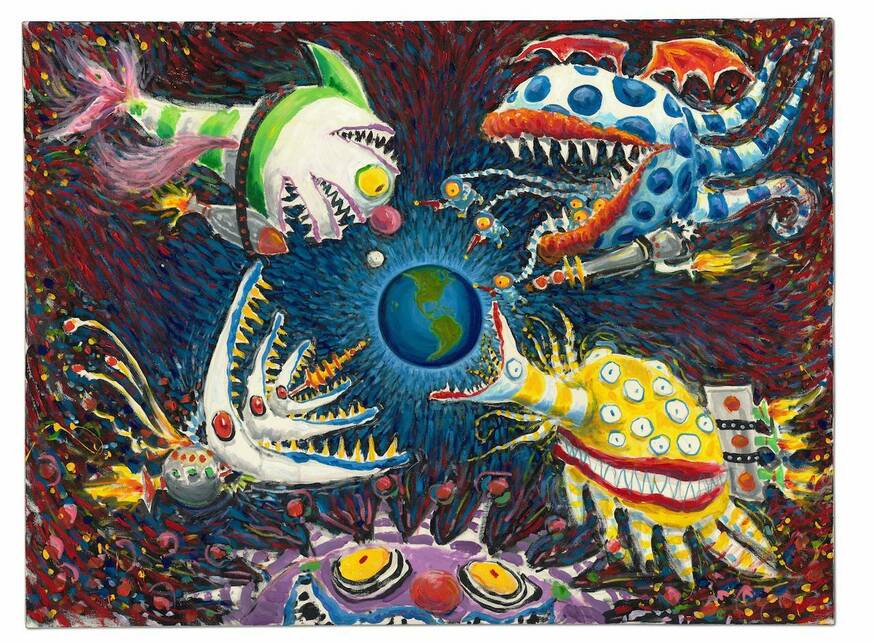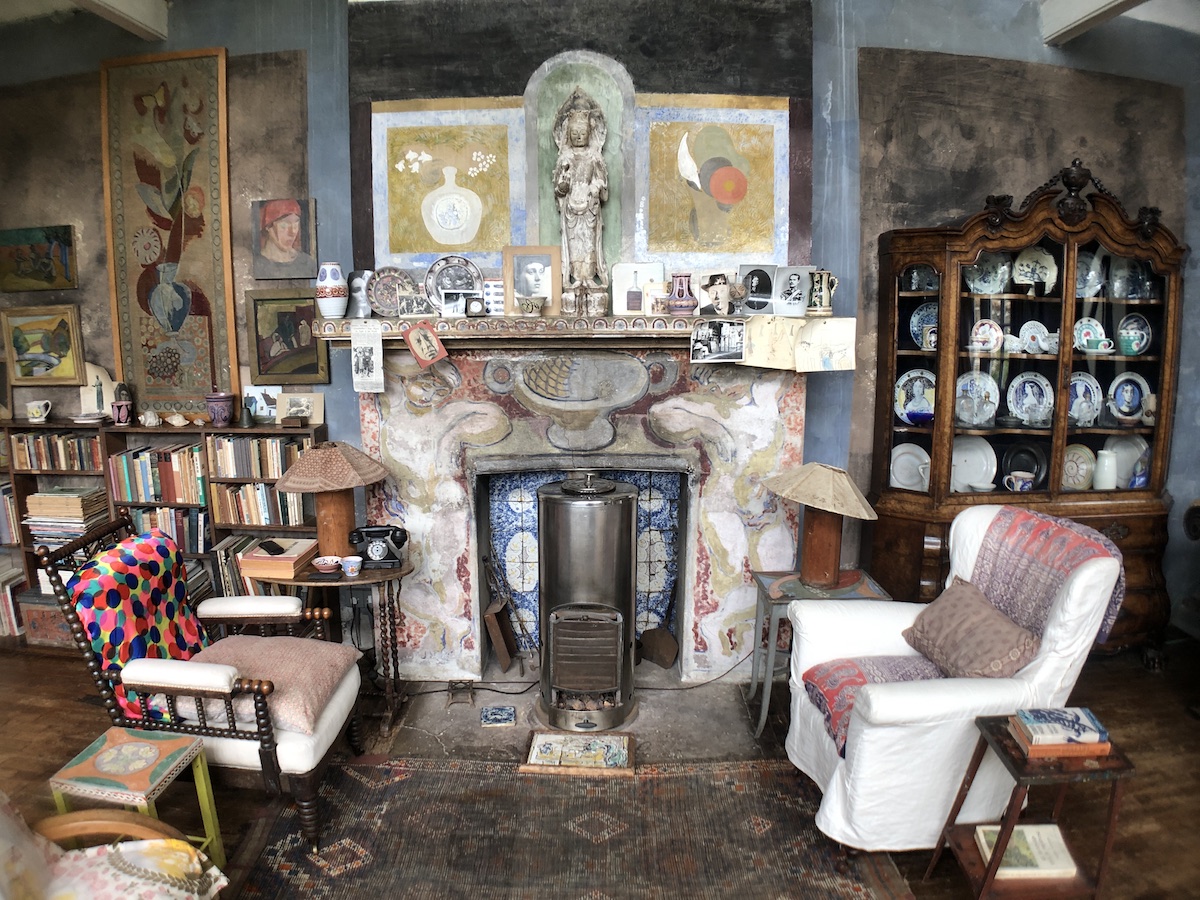Pendulum
2013 - Film & Video (Film & Video)
15:44 minutes
Maya Watanabe
Three men with their backs to each other, dressed similarly in dark colors, stare straight at the camera. They individually deliver sacred lines from the Torah, New Testament, and Qur’an in their representative languages: Old Hebrew, Greek, and Old Arabic. As the camera slowly rotates around the trio, the men begin to perform traditional manifestations of each religious cult: Torah Cantillations, Gregorian Chants, and tilawat of Al-Qur’an. The chanting is interspersed with subtitled translations that reveal similarities and connections between each text—names, locations, and subjects are repeated—complicating the relationship between them. It is unclear which voice is which, and what story they are trying to tell. Much like the amalgamation of voices and meanings in Maya Watanabe’s Pendulum , Peru’s religion is a blended mix of beliefs representative of the country’s history. The predominant religion in the country is Roman Catholic, something that the Spanish conquerors of Peru sought. Many churches were built during this period and convents were also built on ancient Inca sites. Yet indigenous religions and practices persisted and fused with Catholicism resulting in a hybrid of spirituality and religion. Watanabe’s video, El Contorno (2011), which is part of the KADIST collection, operates on a similar level to Pendulum . Both consider language and identity which both become fluid and unfixed as the characters strive to dissolve their unique subjectivities.
Drawing on her background in theater design and direction, Maya Watanabe is known for her multi-channel video installations that explore the relationship between language, collectivity, identity, and space. Considering words, silences and the interweaving of the two, her videos are often slow, controlled, and cyclical in nature. Earlier works incorporate references and methodologies from cinematographic language, often involving one or several actors performing a script and interacting with the camera through choreographed movements. The texts narrated by the actors are either borrowed quotes from movies or modified poems and scripts, which become untethered when taken out of their original context. The ambiguity and lack of narrative that results reveals the imprecise nature of perception and the images and memories that we rely to construct identity. Recent works examine the landscape, exploring their tendency towards the fantastical and ability to conjure memories. With particular attention to the legacy and history of Peru, her work considers the fragmented, uprooted, and mutable past of a place, and how issues of historical instability can take centuries to resolve.
Colors:
Related works sharing similar palette

© » ARTOMITY
Zhang Wenzhi – ARTOMITY 藝源 Tiger in Mountains, Deer at Ocean / Blindspot Gallery / Hong Kong / Nov 28, 2023 – Jan 13, 2024 / Tiger in Mountains, Deer at Ocean , curated by Leo Li Chen at Blindspot Gallery, focuses on Zhang Wenzhi’s latest series of works, primarily consisting of large-format ink-on-paper pieces, accompanied by a video...

© » ARTS EQUATOR
Flowing Reflections: “EARTH” at the M1 CONTACT Contemporary Dance Festival 2018 | ArtsEquator Thinking and Talking about Arts and Culture in Southeast Asia Articles Bernie Ng Left: "EARTH", by Rudi Cole and Júlia Robert Parés, HumanHood (UK); Right: "Filled with sadness, the old body attacks" by Kim Jae Duk June 25, 2018 By Jocelyn Chng (960 words, 6-minute read) EARTH opens the 2018 edition of the M1 CONTACT Contemporary Dance Festival, the annual festival organised by T...

© » KADIST
Meschac Gaba
2010The headdresses, woven from artificial hair braids, symbolize historical icons including Martin Luther King, Kwame Nkrumah, Fela Kuti and King Guézo of Dahomey...

© » LENS CULTURE
In Pieces - Photographs by Sophia Bulgakova, Lia Dostlieva, Ola Lanko, Katia Motyleva and Kateryna Snizhko | Book review by Sophie Wright | LensCulture Feature In Pieces In this imaginative collection of photobooks “made with a child in mind,” five artists of Ukrainian descent explore the everyday heroism of life in wartime...

© » LONDONIST
A Tim Burton Exhibition Is Coming To The Design Museum | Londonist A Tim Burton Exhibition Is Coming To The Design Museum In 2024 By Hannah Newlon-Trujillo Hannah Newlon-Trujillo A Tim Burton Exhibition Is Coming To The Design Museum In 2024 See artworks, storyboards and costume designs by Tim Burton...

© » KADIST
Gisela McDaniel
2020Got Your Back by Gisela McDaniel depicts two women of color from different ethnic backgrounds who share similar violent experiences...

© » KQED
Charles Lee at SF Camerawork: Black Cowboys and Their Horses | KQED Skip to Nav Skip to Main Skip to Footer The Do List SF Camerawork Show Honors the Relationship Between Black Cowboys and Their Horses Nia Coats Dec 13 Save Article Save Article Failed to save article Please try again Facebook Share-FB Twitter Share-Twitter Email Share-Email Copy Link Copy Link An installation view of Charles Lee's show 'sweat + dirt' at SF Camerawork...

© » ARTS EQUATOR
Pandemic in the Philippines: A cultural sector on its own | ArtsEquator Thinking and Talking about Arts and Culture in Southeast Asia Articles August 17, 2020 By Katrina Stuart Santiago (2,200 words, 8-minute read) When I was first asked to write about “cultural leadership” in the Philippines, I turned up a blank...

© » LITHUB
How Alien We Seem: On Being Blind and Obsessed with Photography ‹ Literary Hub Craft and Criticism Fiction and Poetry News and Culture Lit Hub Radio Reading Lists Book Marks CrimeReads About Log In Literary Hub Craft and Criticism Literary Criticism Craft and Advice In Conversation On Translation Fiction and Poetry Short Story From the Novel Poem News and Culture History Science Politics Biography Memoir Food Technology Bookstores and Libraries Film and TV Travel Music Art and Photography The Hub Style Design Sports Freeman’s The Virtual Book Channel Lit Hub Radio Behind the Mic Beyond the Page The Cosmic Library The Critic and Her Publics Emergence Magazine Fiction/Non/Fiction First Draft: A Dialogue on Writing Future Fables The History of Literature I’m a Writer But Just the Right Book Keen On The Literary Life with Mitchell Kaplan New Books Network Read Smart Talk Easy Tor Presents: Voyage Into Genre Windham-Campbell Prizes Podcast Write-minded Reading Lists The Best of the Decade Book Marks Best Reviewed Books BookMarks Daily Giveaway CrimeReads True Crime The Daily Thrill CrimeReads Daily Giveaway Log In How Alien We Seem: On Being Blind and Obsessed with Photography M...

© » KADIST
Carolina Caycedo
2014YUMA o la tierra de los amigos (YUMA, or the Land of Friends) by Carolina Caycedo is a large mural containing a series of satellite photographs mounted on acrylic...

© » KADIST
Victor & Sergiy Kochetov
1992Ukraine-Russia / Volleyball by Viktor and Sergiy Kochetov features a concrete monument of women volleyball players before the railway station in the village of Vodyanoye, Kharkiv region...

© » GALERIE MAGAZINE
5 Museum Exhibitions to See in Miami During Art Basel - Galerie Subscribe Art + Culture Interiors Style + Design Emerging Artists Discoveries Artist Guide More Creative Minds Life Imitates Art Real estate Events Video Galerie House of Art and Design Subscribe About Press Advertising Contact Us Follow Galerie Sign up to receive our newsletter Subscribe Installation view of "Hernan Bas: The Conceptualists" at the Bass Museum of Art, Miami Beach...

© » KADIST
Nguyen 'Quoc' Thành
2012A Soldiers’ Garden by Nhà Sàn Collective is a night portrait series located in an army camp outside Hanoi...







